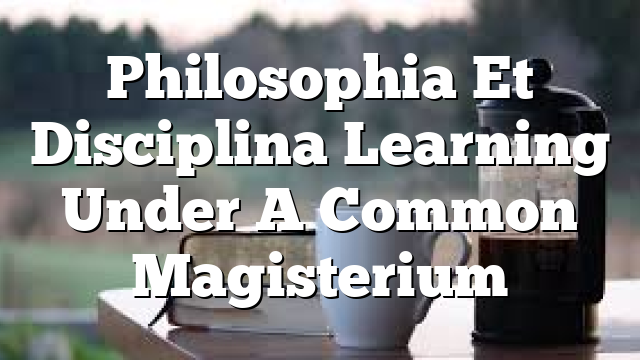Click to join the conversation with over 500,000 Pentecostal believers and scholars
Click to get our FREE MOBILE APP and stay connected
| PentecostalTheology.com



Pneuma 34 (2012) 1-4
Philosophia et disciplina: Learning Under a Common Magisterium
Dale M. Coulter
Almost from the outset, the schools of learning established in Paris during the twelfth century sparked controversy between certain church officials and an emerging group of professional scholars. As early as the 1120s, the great church- man of his day, Bernard of Clairvaux was bringing a young scholar, Peter Abe- lard up on charges of heresy. From Bernard’s perspective, Abelard’s “linguistic turn” was misguided at best, requiring a return to older methods of educating found in monasteries rather than in urban schools where no disciplina, no overarching strategy for formation of the human person, existed. As St. Bene- dict had written in his rule, the monastery was its own school, a school of virtue where formation occurred through a comprehensive way of life. This contro- versy between what were in fact two diverse forms of disciplina, two seemingly irreconcilable types of formation, has inspired multiple trajectories within pentecostalism from short-term Bible training schools, which kept the focus narrowly on mission and evangelism, to the current universities and their embrace of all academic disciplines.
While the debate as to how best to relate the church and the academy will continue, it is possible to avoid the kinds of divisions and mutual condemna- tions that have erupted in the past. A starting point is to recognize that the formation of the human person is a shared aim of both, and that both groups have various traditions they employ to achieve this aim. In its ancient sense, disciplina referred to learning or instruction, which is why Latin writers described the liberal arts as disciplinae and were happy to talk about moral well being in terms of disciplina. This corresponds closely to Pierre Hadot’s analysis of ancient philosophy as a way of life that promoted human flourish- ing. Some Christian writers have recognized the continuity between the pro- grams of learning and the church insofar as both began and ended with formation. What one finds in the academy are traditions of inquiry (to borrow
© Koninklijke Brill NV, Leiden, 2012 DOI: 10.1163/157007412X627864
1
2
D. M. Coulter / Pneuma 34 (2012) 1-4
from Alasdair MacIntyre) or “disciplines” that seek to form human persons. The church too, in its own way, seeks to promote spiritual disciplines as a vehi- cle of human flourishing.
Despite their differences, the church and the academy can come under a common magisterium in light of their common telos. The authority stems from a shared desire to facilitate human flourishing as an aim of learning and the shared recognition that any such facilitation requires the cooperation of indi- vidual humans rather than their coercion. Of course, for the church, this aim must remain penultimate in relationship to union with God. At the same time, pursuit of human flourishing implies common cause in a shared humanism centered upon the moral and spiritual formation of the human person. To put it in “church” language, it is about the sanctified and charismatic lives. While this overarching telos functions as a kind of magisterial authority that informs both church and academy, one might also say that ultimately the magisterium is the eschatological in-breaking of the Spirit in creation and redemption who always authorizes and advances human persons to realize their divine destiny in ways commensurate with human freedom.
The common telos also supplies a context of mutual understanding from which the various traditions that church and academy embody can translate their beliefs and practices for one another. As MacIntyre indicates in Whose Justice? Which Rationality?, the translatability of traditions depends upon a common frame of reference to which both have access. More than that, how- ever, church and academy must recognize that they both are traditions, sets of beliefs and practices embodied in a shared narrative of discourse, which not only informs ongoing reflection, but also must be critically interrogated. The difference is that within the academy these beliefs and practices relate to a tradition of inquiry rather than a tradition that seeks to advance a more com- prehensive narrative about life in general. Each tradition can help the other to reflect more deeply upon its beliefs and practices in light of their shared humanism, which supplies the context for mutual understanding and translat- ability. I have called this shared humanism a common investment in the for- mation of the human person and suggested that it functions as a kind of magisterium.
Since traditions, as Ken Archer has argued following MacIntyre, require a narrative that supplies the rationality for their beliefs and practices, it is crucial that each tradition have a clear grasp of that narrative and how it functions. This is, indeed, one way in which the academy can help the church in its task of formation, or, in the church’s language, discipleship. For pentecostalism, gaining clearer insight into the beliefs and practices that fill out the common
2
D. M. Coulter / Pneuma 34 (2012) 1-4
3
narrative structure of the pentecostal story has never been more urgent. This is part of the role that the Society for Pentecostal Theology (SPS) plays, as an aca- demic society, and that role remains central to Pneuma’s own identity.
In the current issue, for example, Usher’s and Elliott’s articles help clarify the international conduits that set the stage for and advanced early pentecostal- ism. By providing further insight on Cecil Polhill’s patronage of early pentecos- tals, Usher not only shows the financial backing of many early pentecostal missions, he also reveals how easily someone could move between Keswick spirituality and pentecostal spirituality. Elliott’s argument that Edward Irving’s Catholic Apostolic Church (CAC) laid the foundation for pentecostalism in Australia further shows the connections between Britain, Australia, and the United States, especially when one considers that John Alexander Dowie was operative in Sydney between 1875 and 1888.
Another way in which SPS and Pneuma, as academic entities, serve pente- costal churches is by biblical and theological analysis that helps foster critical self-reflection upon the pentecostal narrative identity. A closer reading of Elliott’s investigation of Irving’s CAC reveals how Irvingites were combining the charismatic and the sacramental. Within CAC settings, physical healing occurred during the administration of holy communion, baptism, and holy anointing. This insight closely aligns with Gros’s comparison of the early Fran- ciscans with pentecostalism. As a lay movement of popular piety, the Francis- cans constantly challenged the institutional church of their day. Moreover, this challenge only deepened with Francis’s vision of the crucified Christ and his reception of the stigmata because it implied that the way of penance or holi- ness was the primary conduit of charismatic grace rather than the sacraments themselves. Likewise, contemporary pentecostal scholars have begun to recon- sider the importance of the sacraments as part of a robust theology of encoun- ter. The tension between the sacramental and the charismatic ultimately calls for further theological reflection on the numerous ways in which sacramental grace confirms and charismatic grace challenges the life of the institutional church. The church requires both the prophetic and the priestly dimension of Christian life as critical components of ongoing renewal.
Finally, Marti’s and Gudorf ’s articles reveal how the pentecostal narrative identity continues to adapt within a global context, the former by a focused study on a single church in Los Angeles and the latter by a sociological analysis of the interactions of a pentecostal minority with a Muslim majority in Indone- sia. Their articles illumine the challenges of the global marketplace and nego- tiating that marketplace as a religious minority, as well as the way these challenges shape pentecostal beliefs and practices.
3
4
D. M. Coulter / Pneuma 34 (2012) 1-4
Out of their shared commitment to humanism, the church and the academy find a telos that provides magisterial oversight to their respective traditions. From this perspective, the “disciplines” of the academy can inform the spiritual disciplines of the church as they both challenge and clarify the narrative struc- ture so crucial to pentecostal identity. While this is just a starting point, it is worth remembering when the inevitable conflicts emerge between both insti- tutional forms of disciplina.
Speaking of the academy, Amos and I would like to thank the over thirty anonymous reviewers who helped ensure that Pneuma articles met academic standards since we assumed editorial responsibility in 2010. Stemming from almost every continent, our reviewers reflect the global and ecclesial breadth of the movement. They also span various disciplines with anthropologists, sociologists, biblical scholars, theologians, ethicists, and historians, who work at state and private universities as well as seminaries, all lending their exper- tise. The peer-review system is a critical part of maintaining the traditions of inquiry that form the heart of academic disciplines. For this reason, we begin our first issue of 2012 with a salute to those academics who have volunteered their time to help Pneuma fulfill its mission, which includes aiding the church in forging a genuine humanism, open to the winds of the Spirit. Finally, we also want officially to welcome our new book editor, Néstor Medina, whose exper- tise on Latino/a pentecostalism will further enrich the dialogue between church and academy.
4




Most Talked About Today